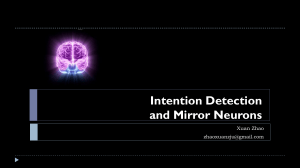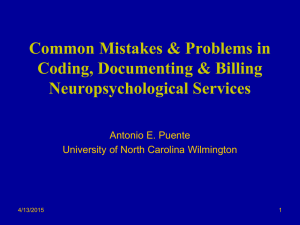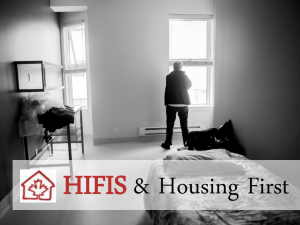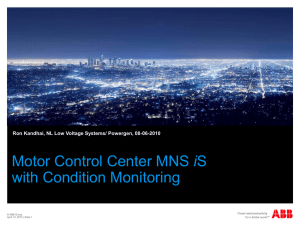Medical Needs Shelter - New Jersey Learning Management Network
advertisement
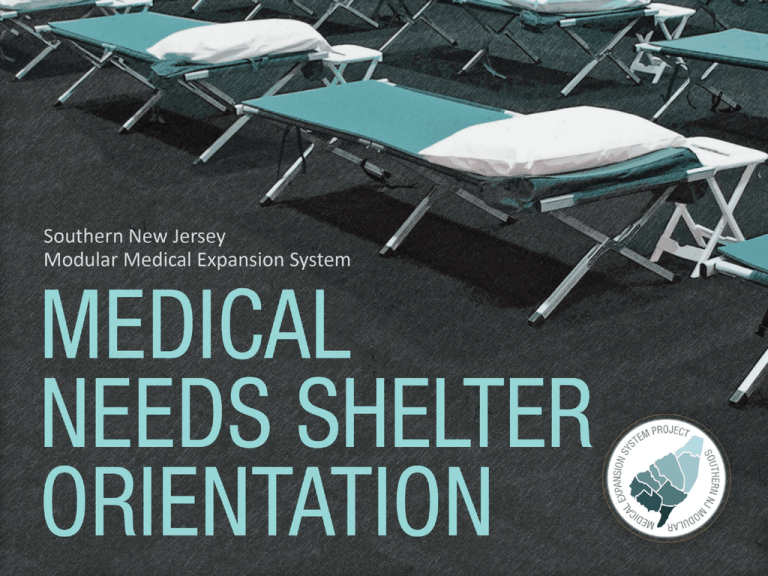
Introductions – Instructor(s) – Participants • Name • Agency • What you hope to learn from today’s class 2 Housekeeping Issues – Emergency Exits – Restrooms – Breaks 3 Course Description This course introduces and focuses on the medical needs component of mass care and sheltering in either a colocated or stand-alone shelter setting. This course will mainly focus on which populations are expected in medical needs shelters (MNSs) and outlines the criteria for establishing, operating, and demobilizing a MNS. The course also discusses how counties coordinate and share resources throughout the region. 4 Course Objectives At the end of this course, the participant will: – Understand the purpose of a MNS – Differentiate between which populations are served in a MNS – Understand the capabilities and limitations of MNS – Understand the MNS triage criteria – Understand roles and responsibilities in a MNS – Discuss how counties coordinate for MNS in the southern New Jersey region 5 Units in the Course This course comprises the following units: – Unit 1 – Medical Needs Sheltering – Unit 2 – Types of Medical Needs Shelters – Unit 3 – Medical Needs Shelter Standard Operating Guideline (SOG) – Unit 4 – Concept of Operations – Unit 5 – Agency Roles & Responsibilities – Unit 6 – Scenario – Unit 7 – Course Summary 6 Knowledge Check At the end of each unit, there will be a brief knowledge check. 7 Unit 1 – Medical Needs Sheltering PHOTO 8 Unit 1 – Medical Needs Sheltering Unit Introduction When disasters strike, a county’s diverse population requires adequate care and sheltering. Individuals with medical needs require more assistance than those located within a community shelter, but how do we care for them? 9 Unit 1 – Medical Needs Sheltering At the end of this unit, the participant will: – Describe the difference between Access and Functional Needs and Medical Needs – Describe the difference between medical needs and nonmedical needs – Define medical needs shelter – Recognize why a MNS may need to be established – Identify populations who should be sheltered in a MNS – Identify MNS agency, facility, and volunteer partners 10 Unit 1 – Medical Needs Sheltering Access and Functional Needs – Groups whose needs are not fully addressed by community shelters, but who may be accommodated in a community shelter with minor assistance. Medical Needs – Groups whose medical needs can not be accommodated in a community shelter, but who are not critical enough for transportation to a permanent healthcare facility. This course will focus only on the medical needs aspect of sheltering and mass care 11 Unit 1 – Medical Needs Sheltering Who is included in the medical needs population? Individuals with no acute medical conditions but who require some medical care and/or special assistance beyond what is available in a community shelter. 12 Unit 1 – Medical Needs Sheltering Who is not included in the medical needs population? Individuals with pre-existing health problems that do not impede activities of daily living and do not exceed the basic first aid capabilities of community shelters. 13 Unit 1 – Medical Needs Sheltering What is medical needs sheltering? The basic care and supervision of medical needs patients by healthcare professionals outside of a hospital or acute care environment. 14 Unit 1 – Medical Needs Sheltering Who would you expect in a MNS? – Hospice patients – Wheelchair-bound person with additional medical conditions – Patients with draining wounds requiring frequent dressing changes – Patients who have undergone recent major surgery – Home health patients 15 Unit 1 – Medical Needs Sheltering Why would a county establish a MNS? – A MNS may be activated during a widespread disaster or a localized incident. – A county may establish a MNS when patients with medical needs arrive at a community shelter where their needs cannot be supported. 16 Unit 1 – Medical Needs Sheltering Why not just send people with medical needs to a hospital? – During an incident, hospitals and other healthcare facilities could become overwhelmed. – This surge can cause a strain on hospital resources and personnel. – Medical needs patients do not have acute conditions, and thus a hospital is not the most appropriate location for them. 17 Unit 1 – Medical Needs Sheltering The following organizations/agencies are community partners in medical needs sheltering: – – – – – – – – County Office of Emergency Management County Health Department Local hospitals Voluntary Organizations Active in Disaster (VOAD) Community emergency response agencies Other local and county agencies Medical Reserve Corps Community Emergency Response Team 18 Unit 1 – Medical Needs Sheltering When considering the opening of a MNS, certain guidelines must be followed to ensure smooth operation. The following key points should be remembered: – A MNS may need to be established if population needs cannot be met at a community shelter or if hospital resources are at risk for being overwhelmed. – Not all evacuees who have medical issues belong in a MNS. Some belong in a community shelter while others belong in a hospital. – Multiple participants assist in the activation and operation of a MNS. These range from volunteers and hospitals to state and local agencies. 19 Unit 1 – Medical Needs Sheltering Unit Summary In this unit we discussed: – The situations that may require a MNS activation – What a MNS is and who typically requires a MNS – What are considered medical needs, and what is typically not considered medical needs 20 Knowledge Check Question 1 – What are considered medical needs? Question 2 – Are individuals with access and functional needs considered medical needs? Question 3 – When might a county decide to open a MNS? Question 4 – Name a few examples of individuals who are considered medical needs. 21 Unit 2 – Types of Medical Needs Shelters Unit 2 – Types of Medical Needs Shelters Unit Introduction Once the need has been identified, counties must take steps to activate one of two types of MNS. The type of the MNS varies based on availability resources within the county and the predetermined location of the MNS. This unit will focus on the different types of MNS and how they operate. 23 Unit 2 – Types of Medical Needs Shelters At the end of this unit, the participant will: – Identify and describe the two types of MNS – Recognize what type of MNS may be opened in your county – Identify standard requirements for both types of MNS 24 Unit 2 – Types of Medical Needs Shelters Several models for establishing and operating a MNS exist: – A MNS in a building that is independent from other sheltering operations (stand-alone MNS) – A MNS that is located in the same building or campus as the community shelter (co-located MNS) 25 Unit 2 – Types of Medical Needs Shelters Stand-Alone MNS A stand-alone MNS is located at a facility that only shelters evacuees with medical needs. The stand alone MNS may be located at a non-traditional facility or other location identified by the municipality/county 26 Unit 2 – Types of Medical Needs Shelters Stand-Alone MNS – May be located at an existing shelter that is not used for community sheltering – A suggested location is in a setting where there is a medical infrastructure in place (e.g., at a college that has a nursing program) – Requires all support services (e.g., food, shelter management, power) that are in community shelters 27 Unit 2 – Types of Medical Needs Shelters Co-Located MNS A co-located MNS is at a facility where the community shelter is also located. The MNS may be a portion of the shelter, or may be located in a room that is separate from the community shelter. 28 Unit 2 – Types of Medical Needs Shelters Co-Located MNS – The community shelter operator arranges for general shelter management services (e.g., food, registration, sanitary services, etc.) – The MNS is located in an adjacent room or building and only allows medical needs patients to stay in that area. – The MNS may operate on an “appointment” basis. 29 Unit 2 – Types of Medical Needs Shelters Comparison of Models Stand-Alone MNS Co-located MNS Support Services (e.g., food, supplies, etc.) Provided by the agency operating the MNS Provided by the community shelter Capacity May be limited based on staffing and resources May be expanded using resources from the community shelter Evacuee (patient) Duration in MNS Must stay in the MNS throughout the duration of the incident May schedule “visits” into the MNS for treatment and then return to the community shelter Transportation May require transportation between the MNS and the community shelter All evacuees are at the same location Staffing County staff, hospital staff, home health, VOAD County staff, hospital staff, home health, VOAD 30 Unit 2 – Types of Medical Needs Shelters Despite the differences between the MNS models, common elements exist: – The footprint must be at least 2,000 square feet. – The MNS must have power and backup generator power, and must be climate controlled. – The MNS must be ADA compliant. – The MNS must be staffed 24 hours a day with rotating staff in defined operational periods. – The scope of care is identical. 31 Unit 2 – Types of Medical Needs Shelters Unit Summary In this unit we discussed: – Various models for a MNS – The benefits and drawbacks of each MNS model – The responsibilities related to shelter support services 32 Knowledge Check Question 1 – What are the two MNS models? Question 2 – Compare and contrast the two MNS models discussed in this unit. Question 3 – What is the minimum square footage for a MNS? Question 4 – When a MNS is not located with a community shelter, who must provide shelter support services? 33 Unit 3 – Medical Needs Shelter SOG Unit 3 – Medical Needs Shelter SOG Unit Introduction In this unit we will explore how a MNS is coordinated in counties in Southern New Jersey. The county MNS SOG is the document that guides MNS operations. We will examine the various elements of the SOG and discuss the importance of each piece. 35 Unit 3 – Medical Needs Shelter SOG At the end of this unit, the participant will: – Understand how the SOG guides MNS operations in the county – Be familiar with various tools that are included in the SOG appendices – Recognize the conditions in which a MNS may be activated 36 Unit 3 – Medical Needs Shelter SOG The county MNS SOG provides operational guidance for setup, operation, and demobilization of the MNS. 37 Unit 3 – Medical Needs Shelter SOG Sections of the SOG – – – – – – Background Purpose Planning Assumptions Concept of Operations Roles and Responsibilities Plan Maintenance 38 Unit 3 – Medical Needs Shelter SOG SOG – Background, Purpose These sections provide a general setting for the SOG and background information regarding what a MNS is and when the use of a MNS is appropriate. 39 Unit 3 – Medical Needs Shelter SOG SOG – Planning Assumptions This section outlines the conditions that are assumed to exist if a MNS is activated within the county. 40 Unit 3 – Medical Needs Shelter SOG SOG – Concept of Operations This section outlines how the MNS will be activated, operated, and demobilized. This section also outlines how resources and the facility will be coordinated to support the MNS. 41 Unit 3 – Medical Needs Shelter SOG SOG – Roles and Responsibilities This section assigns responsibility for various elements related to the MNS. 42 Unit 3 – Medical Needs Shelter SOG SOG – Plan Maintenance This section establishes how the SOG will be updated, how training will occur, and how exercises will be carried out as part of a regular schedule. 43 Unit 3 – Medical Needs Shelter SOG The SOG is supported by a series of appendices that provide documentation and job aids to assist in operating a MNS. 44 Unit 3 – Medical Needs Shelter SOG Appendix 1 – Acronyms This section provides a list of acronyms that are used throughout the SOG. 45 Unit 3 – Medical Needs Shelter SOG Appendix 2 – Triage Guidelines This appendix provides a standard set of guidelines for triage to determine if evacuees: – Can stay in the community shelter – Require care in the MNS – Have an acute condition or one that requires a transfer to a hospital 46 Unit 3 – Medical Needs Shelter SOG Appendix 3 – Staffing and Organization This section provides detailed guidance regarding the qualifications and responsibilities of MNS staff. 47 Unit 3 – Medical Needs Shelter SOG Appendix 4 – MNS Site Locations This appendix outlines where the primary and secondary MNS sites are located. 48 Unit 3 – Medical Needs Shelter SOG Appendix 5 – Memorandums of Agreement This section contains relevant agreements that are in place that are relevant to medical needs sheltering. 49 Unit 3 – Medical Needs Shelter SOG Appendix 6 – County Support Service Providers This appendix contains listings and contact information for staff and other resources that may assist in medical needs sheltering. 50 Unit 3 – Medical Needs Shelter SOG Appendix 7 – Supply Lists This appendix contains a list of medical supplies that are needed to operate a MNS. These supplies are located in the MNS trailer. 51 Unit 3 – Medical Needs Shelter SOG Appendix 8 – Site Forms This appendix contains relevant forms needed to operate the MNS. Examples of items included are evacuee (patient) intake forms and triage forms 52 Unit 3 – Medical Needs Shelter SOG Appendix 9 – Waivers This appendix contains a series of pre-scripted waivers that may be needed to operate the MNS 53 Unit 3 – Medical Needs Shelter SOG Appendix 10 – Sample Media Release Operation of the MNS will require outreach to the public. This appendix contains media releases that may be used during medical needs sheltering operations. 54 Unit 3 – Medical Needs Shelter SOG Unit Summary In this unit we discussed: – The MNS SOG and supporting appendices – Tools that are available for MNS activation, operation, and activation 55 Knowledge Check Question 1 – What is the purpose of the MNS SOG? Question 2 – Where in the SOG will you find supporting tools to assist with MNS operations? Question 3 – What is the purpose of the Roles and Responsibilities section? Question 4 – Where in the SOG are triage guidelines located? 56 Unit 4 – Concept of Operations Unit Introduction In this unit we will examine the concept of operations in greater detail, keeping in mind the SOG document and the role it plays in MNS operations. We will discuss activation, setup, operation, and demobilization of the MNS. Specific operations may vary slightly based upon the size and scope of the incident as well as resources available for the MNS. 58 Unit 4 – Concept of Operations At the end of this unit, the participant will: – Be familiar with operations associated with a MNS throughout the entire process – Understand the importance of prompt and effective triage of evacuees 59 Unit 4 – Concept of Operations MNS Staffing The MNS is staffed by a team of medical and nonmedical personnel who collectively work together to operate the MNS. 60 Unit 4 – Concept of Operations MNS Staffing MNS Site Coordinator Administrative Section Chief Administrative Support Case Manager Operations Section Chief Logistics Section Chief Resource Manager Security Officer(s) Triage Officer (RN or higher) RN (1) LPN (1) Evacuee (Patient) Care Technician (3) Pharmacy Mental Health Counselor EMS Transport Crew Clergy 61 Unit 4 – Concept of Operations MNS Staffing MNS Site Coordinator Administrative Section Chief Administrative Support Case Manager Operations Section Chief Logistics Section Chief Resource Manager Security Officer(s) Triage Officer (RN or higher) RN (1) LPN (1) Evacuee (Patient) Care Technician (3) Pharmacy Mental Health Counselor EMS Transport Crew Clergy 62 Unit 4 – Concept of Operations MNS Staffing Administrative Section Chief Administrative Support Case Manager MNS Site Coordinator Logistics Section Chief Resource Manager Security Officer(s) Operations Section Chief Triage Officer (RN or higher) RN (1) LPN (1) Evacuee (Patient) Care Technician (3) Pharmacy Mental Health Counselor EMS Transport Crew Clergy 63 Unit 4 – Concept of Operations MNS Staffing MNS Site Coordinator Administrative Section Chief Administrative Support Case Manager Operations Section Chief Logistics Section Chief Resource Manager Security Officer(s) Triage Officer (RN or higher) RN (1) LPN (1) Evacuee (Patient) Care Technician (3) Pharmacy Mental Health Counselor EMS Transport Crew Clergy 64 Unit 4 – Concept of Operations MNS Staffing Administrative Section Chief Administrative Support Case Manager MNS Site Coordinator Logistics Section Chief Resource Manager Security Officer(s) Operations Section Chief Triage Officer (RN or higher) RN (1) LPN (1) Evacuee (Patient) Care Technician (3) Pharmacy Mental Health Counselor EMS Transport Crew Clergy 65 Unit 4 – Concept of Operations Activation There are several instances in which a MNS may be activated. As a result of a sudden incident In anticipation of an incident 66 Unit 4 – Concept of Operations Activation The decision to activate the MNS will likely be a joint decision between the Office of Emergency Management (OEM) and the Health Department. It may be based upon requests to shelter medical needs evacuees (patients) who arrive at a shelter, or it may occur in anticipation of a slowmoving hazard such as a winter storm or hurricane. 67 Unit 4 – Concept of Operations Activation Once the decision is made to activate the MNS, a MNS Site Coordinator will be designated. The MNS Site Coordinator is responsible for overseeing all on-site operations at the MNS. 68 Unit 4 – Concept of Operations Activation Once the MNS is activated, the MNS trailer will be transported to the MNS site. Staff will meet the trailer at the site to set up the MNS. The standard size of the MNS trailer cache is 25 beds. Additional evacuees (patients) can be accommodated if resources and staffing are sufficient to support. Representatives from the County and facility will conduct a preincident walk through, noting any existing damages 69 Unit 4 – Concept of Operations Activation The county Emergency Operations Center (EOC) will also be activated to assist with the coordination of MNS operations. Depending on the county’s structure, the MNS will be overseen by either Emergency Support Function (ESF) #6 – Mass Care or ESF #8 – Health and Medical. 70 Unit 4 – Concept of Operations Notifications Once the MNS is activated, the county OEM will need to notify several agencies/organizations: - Medical Reserve Corps Community Emergency Response Team Emergency Medical Services Medical Coordination Center New Jersey Department of Health County Public Information Officer New Jersey Office of Emergency Management Other stakeholders as necessary 71 Unit 4 – Concept of Operations Registration When evacuees (patients) enter the MNS, one of the first activities that needs to be accomplished is registration. Registration forms are available in the SOG Appendix. 72 Unit 4 – Concept of Operations Triage The Triage Officer is located at the point of registration. When an evacuee (patient) enters the shelter, the Triage Officer determines if the evacuee: – Can be safely sustained in a community shelter (Tier 1) – Requires services available in a MNS (Tier 2) – Has a condition that requires transport to an acute care hospital (Tier 3) 73 Unit 4 – Concept of Operations Tier 1 – Community Shelter Individuals who are independent prior to the disaster or emergency. Some of these individuals may have pre-existing health problems that do not impede activities of daily living and do not exceed the basic first aid capabilities of community shelters. 74 Unit 4 – Concept of Operations Tier 1 – Community Shelter – Examples – – – – – – – – – Epilepsy when controlled Controlled insulin-dependent diabetes Hemophilia Ostomies with self-care Vision or hearing impairments Prosthesis Dry wounds requiring basic maintenance by evacuee Asthma, if controlled Functional needs: Wheelchair-bound person or person with other mobility-related disabilities without other medical needs who is able to use the shower or facilities with minimal assistance – Conditions controlled by self-administered medications – Persons requiring dialysis 75 Unit 4 – Concept of Operations Tier 2 – Medical Needs Shelter Evacuees (patients) who have no acute medical conditions but require some medical care and/or special assistance beyond what is available in a community shelter. 76 Unit 4 – Concept of Operations Tier 2 – Medical Needs Shelter – Examples – Conditions listed in Tier 1 that are not evacuee (patient)controlled – Wheelchair-bound person with medical needs – Tracheotomy – Feeding tube – PICC lines – Oxygen-dependent person and a person with other oxygen issues – Draining wounds requiring frequent sterile dressing changes – Persons whose disability prevents them from sleeping in a cot – Hospice patients 77 Unit 4 – Concept of Operations Tier 3 – Acute Care Hospital Facility Evacuees (patients) who need acute medical care such as individuals experiencing significant trauma, injury, or acute medical condition(s). 78 Unit 4 – Concept of Operations Tier 3 – Acute Care Hospital Facility – Examples – – – – – – – – – Evacuees (patients) who are ventilator dependent Pregnancy (gestation >32 weeks or multiple/twin >30 weeks) Pregnant women who are having contractions or are in labor Persons reporting chest pain any time in the last 24 hours or are suspicious of chest pain that is cardiac in nature Acute altered mental status (e.g., lethargic, disoriented, etc.) Comatose individuals Uncontrollable or violent persons Contagious conditions that require special precautions Others requiring the intensity of service only provided at a hospital 79 Unit 4 – Concept of Operations Ongoing Operations – Staffing will be organized in operational periods (typically 12-hour periods). – The county EOC will assist with resource location and acquisition. – If capacity exceeds the availability of resources, mutual aid will be requested. 80 Unit 4 – Concept of Operations Medical Care and Medical Direction – The county will designate a Medical Director who will put standing protocols in place for MNS operations. – MNS staff will provide care under written protocols. – Staffing Ratios • Patient Technician ÷ Patient = 1:10 • Nurse ÷ Patient = 1:20 81 Unit 4 – Concept of Operations Infection Control and Sanitation – All staff members are trained and adhere to standard precautions. – The MNS will be disinfected at regularly scheduled intervals. – The MNS will be maintained through regular cleaning, medical waste disposal, and trash removal. 82 Unit 4 – Concept of Operations Security – The county will designate a law enforcement entity to oversee MNS security. – The MNS must have locking capabilities for sensitive equipment and pharmacy supplies. – All people within the MNS must have some sort of visible identification. – All MNS workers must be credentialed. 83 Unit 4 – Concept of Operations Pharmacy Area – A secure pharmacy location will be identified for the storage of evacuee (patient) medication and other supplies. – The area must have a lockable door. – A refrigerator is required for certain medications (e.g., insulin). 84 Unit 4 – Concept of Operations Mutual Aid – Mutual aid resources may be requested through the county EOC when the situation overwhelms the county’s capabilities. – Each county has a MNS trailer that can be utilized throughout the region if needed. 85 Unit 4 – Concept of Operations Demobilization – The decision to close the MNS will be a joint decision between the county and the MNS Site Coordinator. – All supplies will be replenished and the facility will be returned to pre-incident status. – The representatives from the county and facility will conduct a post-incident walk-through, noting any damages that have occurred. 86 Unit 4 – Concept of Operations Unit Summary In this unit we discussed: – How a MNS is established and how ongoing operations occur – The importance of effective triage in the MNS – The staffing resources needed within the MNS – Various elements of the MNS 87 Knowledge Check Question 1 – When should registration and triage occur? Question 2 – What are some of the considerations for a pharmacy area? Question 3 – An evacuee presents to the shelter with chest pains. What is your course of action? Question 4 – What is the role of the MNS Site Coordinator? 88 Unit 4 – Agency Roles & Responsibilities Unit 5 – Agency Roles & Responsibilities Unit Introduction Now that you have a basic understanding of the reasons why a MNS would be utilized, it is important to know how people from a variety of organizations and agencies work together to provide a MNS. While individual agency roles and responsibilities may differ slightly based upon the county, there are common elements across the region. In this unit we will discuss these common elements. 90 Unit 5 – Agency Roles & Responsibilities At the end of this unit, the participant will: – Be familiar with the roles and responsibilities of agencies involved in a MNS – Describe how these agencies and organizations work collaboratively for a MNS 91 Unit 5 – Agency Roles & Responsibilities County Office of Emergency Management – Provides overall command and control for the MNS – Integrates the MNS into community shelter planning – Activates the EOC and coordinates operations through either ESF #6 or ESF #8 – Provides resource support for MNS operations – May provide staff to assist at the MNS – Coordinates with other county agencies and organizations for MNS issues 92 Unit 5 – Agency Roles & Responsibilities County Health Department – May provide overall direction for the MNS portion of the community shelter – Designates a Medical Director – Oversees medical staffing and credentialing – May represent the MNS at the county EOC – Typically oversees on-site MNS operations 93 Unit 5 – Agency Roles & Responsibilities Emergency Services Organizations – – – – Serves as a potential staffing source for the MNS Can assist with setup and tear down of the MNS EMS may transport evacuees (patients) to the MNS EMS provides an on-site standby crew 94 Unit 5 – Agency Roles & Responsibilities Voluntary Organizations Active in Disaster (VOAD) – Provides staffing support for the MNS – Assists with management functions within the MNS – Assists with setup and tear down of the MNS 95 Unit 5 – Agency Roles & Responsibilities Medical Reserve Corps (MRC) – Provides medical staffing support for the MNS 96 Unit 5 – Agency Roles & Responsibilities Community Emergency Response Team (CERT) – Provides nonmedical staffing support for the MNS – Can assist with setup and tear down of the MNS – Can fulfill general staffing positions within the MNS 97 Unit 5 – Agency Roles & Responsibilities Local Hospital or Hospital System – Can be a source of staffing resources – May assist with locating and securing pharmaceuticals – May provide transportation resources for evacuees (patients) to and from the MNS – May fill other roles as needed 98 Unit 5 – Agency Roles & Responsibilities Medical Coordination Center (MCC) – Provides situational awareness regarding the status of MNSs throughout the region – Tracks the deployment of the MNS and adjusts resources around the region as needed – Assists in filling local resource requests that arrive from national suppliers and other locations – Is a direct link to the New Jersey Department of Health 99 Unit 5 – Agency Roles & Responsibilities Other Agencies/Organizations – May play a support role for the MNS – Can be a source of staffing within the MNS for both medical and nonmedical personnel – May assist with resource support within the MNS 100 Unit 5 – Agency Roles & Responsibilities Unit Summary In this unit we discussed: – Examples of roles and responsibilities for a variety of county agencies and organizations – Possible sources of MNS support – both staffing and material resource support 101 Knowledge Check Question 1 – In your county, what is the role of the OEM? Question 2 – In your county, what is the role of the Health Department? Question 3 – What is the role of the MCC in MNS operations? Question 4 – How will you use voluntary agencies in MNS operations? 102 Unit 6 – Scenario Unit Introduction In this unit we will discuss a real-life scenario in which a MNS may be required. Keep in mind what we have learned thus far in the course. Frame your answers in the context of your role in your respective agency/organization. 104 Unit 6 – Scenario At the end of this unit, the participant will: – Understand the process of activating, operating, and demobilizing a MNS – Describe unique challenges associated with MNS – Understand various roles and responsibilities – Describe their role within their agency/organization related to MNS 105 Unit 6 – Scenario Scenario A low-pressure system develops near the Cape Verdes Islands, and the National Hurricane Center believes this area of disturbance has the potential to develop into an organized storm. 106 Unit 6 – Scenario Scenario The system develops into a tropical storm, and early projections indicate the storm will intensify and likely will impact the MidAtlantic region, specifically the Delmarva peninsula and the New Jersey coast. 107 Unit 6 – Scenario Scenario Although the storm’s projected landfall is more than 72 hours away, the Governor of New Jersey has ordered mandatory evacuations of low-lying areas and the barrier islands along the coast. 108 Unit 6 – Scenario Scenario Evacuations are in progress, community shelters are opening, and the county EOC is beginning to receive requests to open a MNS, as evacuees are arriving at community shelters with medical needs. 109 Unit 6 – Scenario At this point, the request has been made for a MNS. What are your next steps? 110 Unit 6 – Scenario How will you decide upon the appropriate location for the MNS? 111 Unit 6 – Scenario What MNS model has your county decided upon during pre-planning efforts? 112 Unit 6 – Scenario What resources may be at your disposal, and how will you acquire them? 113 Unit 6 – Scenario What notifications will you make once the MNS and the MNS trailer have been activated? 114 Unit 6 – Scenario Who will arrive to set up the MNS? 115 Unit 6 – Scenario Where will triage take place? What types of evacuees (patients) will you accept into the MNS? 116 Unit 6 – Scenario How many evacuees (patients) do you anticipate the MNS being able to accommodate? What procedures are in place should the MNS become overwhelmed? 117 Unit 6 – Scenario How will you obtain and restock medical and general supplies within the MNS? 118 Unit 6 – Scenario At what point will you decide to demobilize, and who will make the call? 119 Unit 6 – Scenario Unit Summary In this unit we discussed: – The situation and conditions that may require activation of the MNS – How your organization or agency would contribute to a MNS operation – Sources of assistance within the MNS process 120 Unit 6 – Course Summary Unit 7 – Course Summary Unit Introduction In this course we have discussed the purpose for, the operation of, and your agency’s/organization’s role in medical needs sheltering in the county. In this unit we will briefly review the pertinent concepts related to MNS. 122 Unit 7 – Course Summary Topics Covered in the Course During this course we have covered: – – – – – What medical needs are The basics of medical needs sheltering The importance of the MNS SOG within the county The roles that various agencies play in a MNS How a MNS is accomplished in the County 123 Unit 7 – Course Summary What Are Medical Needs? Individuals with no acute medical conditions but who require some medical surveillance and/or special assistance beyond what is available in a community shelter. 124 Unit 7 – Course Summary Typical evacuees (patients) include: – Hospice patients – Wheelchair-bound person with additional medical conditions – Patients with draining wounds requiring frequent dressing changes – Patients who have undergone recent major surgery – Home health patients 125 Unit 7 – Course Summary Medical Needs Sheltering The basic care and supervision of medical needs patients by healthcare professionals outside of a hospital or acute care environment. The MNS can be: – A stand-alone facility – Co-located with a community shelter 126 Unit 7 – Course Summary The MNS SOG – Outlines the activities that need to occur for a successful MNS operation – Describes roles/responsibilities of organizations – Is accompanied by supporting appendices that contain tools for MNS operations – Describes how counties in the region coordinate MNS operations 127 Unit 7 – Course Summary MNS Operations in Each County – MNS operations may differ slightly than what is described in this course. – Each county has the same starting point as a result of the Southern NJ MMES Project. – Triage guidelines and the standard of care is uniform across the region. 128 Final Exam The final exam comprises of 15 multiple choice questions that cover a variety of topics discussed in this course. You have as much time as needed to complete the exam. 129 Course Completion You have successfully completed the Southern New Jersey MMES Project Medical Needs Shelter Orientation Course. 130





